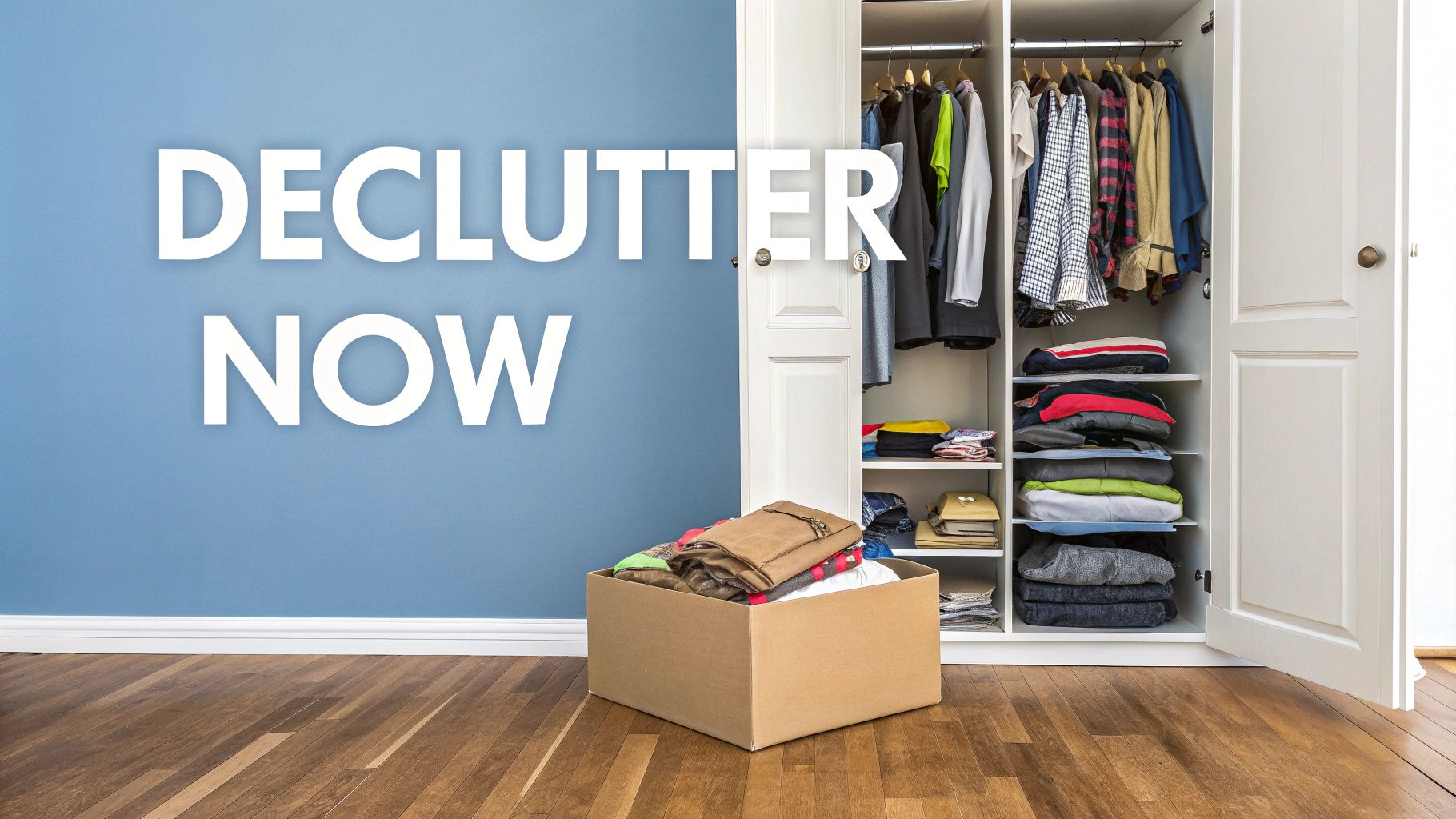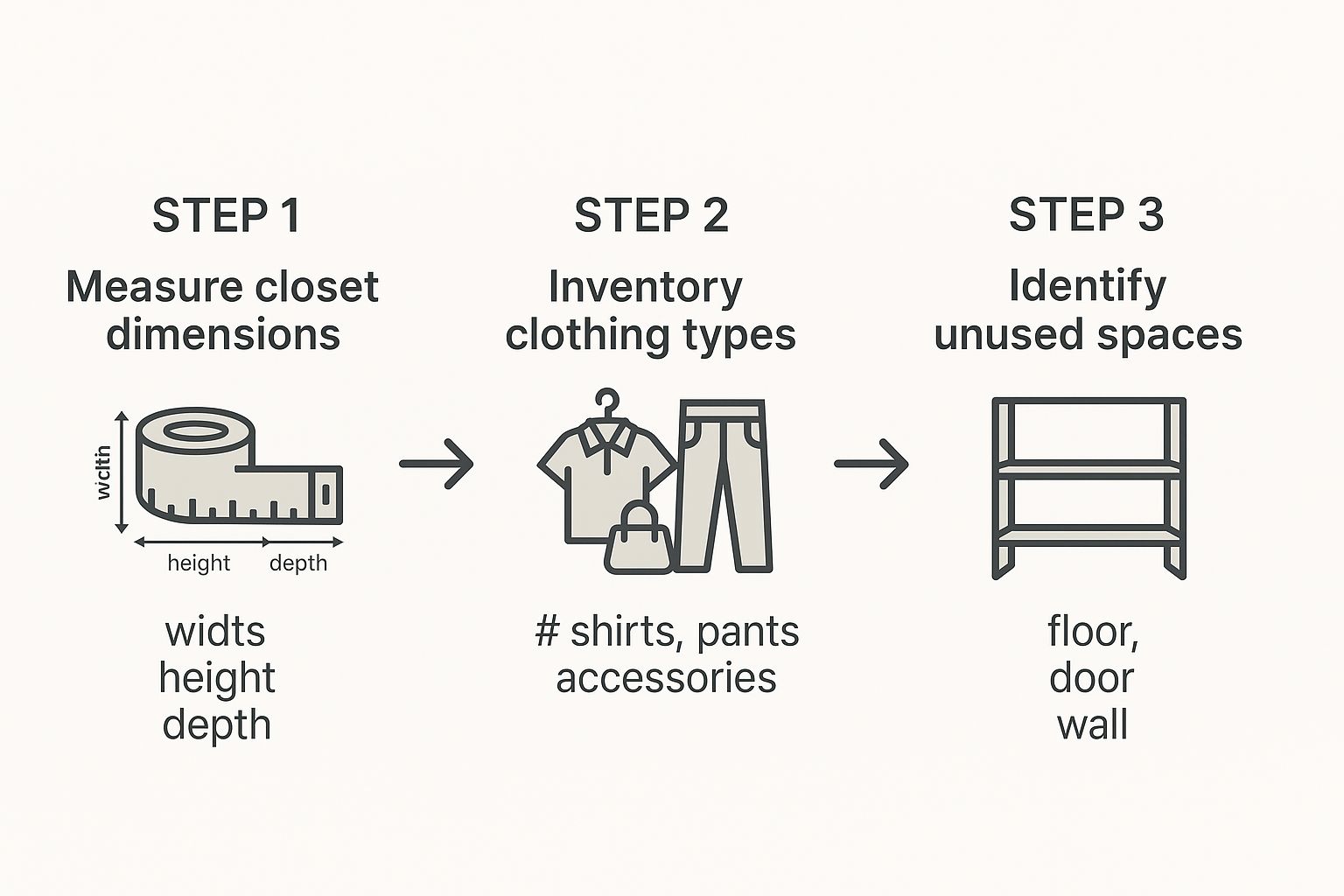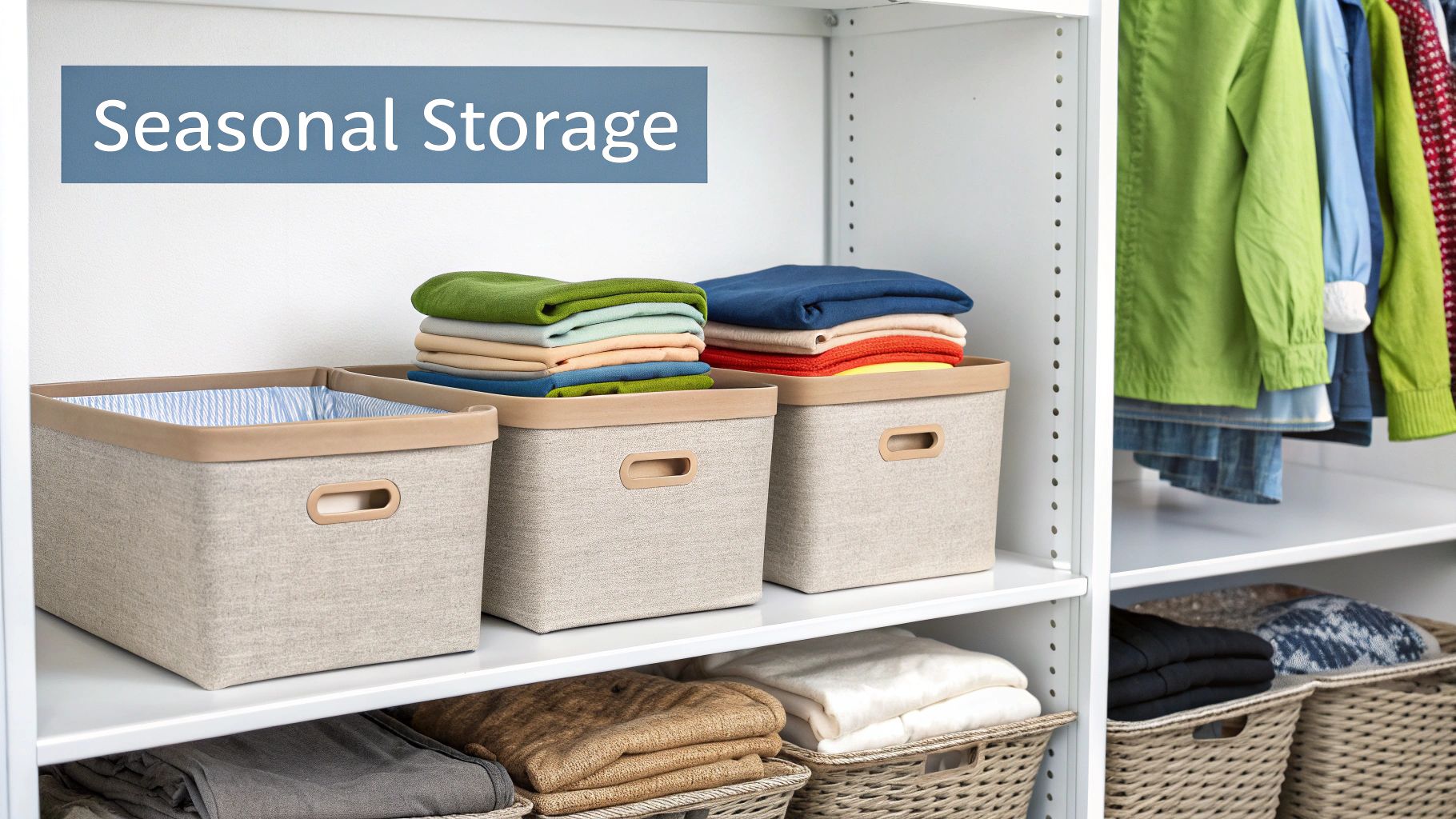How to Create More Closet Space Through Smart Organization

Is your closet bursting at the seams? If you're constantly fighting for space, the answer isn't a bigger closet—it's smarter organization. To truly reclaim your space, you have to start with the fundamentals: assess what you have, purge what you don't need, and categorize what's left. It’s a simple but incredibly effective way to lay the groundwork for a perfectly organized wardrobe that actually works for you.
Your First Steps to a More Organized Closet
Before you even think about buying a single storage bin or a new set of hangers, the most powerful thing you can do is take a good, hard look at what’s already in there. Let's be honest, most of us only wear a fraction of our clothes regularly. That means your closet is likely clogged with items that are just taking up prime real estate.
The goal here isn't just to tidy up. It's about making intentional choices that will simplify your life, create a functional system, and instantly free up space.
The 3-Phase Closet Organization Plan
This is a quick overview of the essential first steps for reclaiming your closet space through organization. Think of it as your game plan.
| Phase | Action Item | Goal |
|---|---|---|
| Assess | Take inventory of your clothes and measure your closet dimensions. | Understand exactly what you're working with—both in terms of your wardrobe and the physical space. |
| Purge | Go through every single item and decide what to keep, donate, sell, or toss. | Eliminate the excess to create a curated collection of items you actually wear and love. |
| Categorize | Group the remaining items into logical piles (e.g., workwear, casual tops, pants). | Set the stage for an organized system where everything has a home and is easy to find. |
This process sets you up for organizational success before you start putting things back.
The first part of this, the assessment, is where you get a clear picture of the situation. It’s about more than just a quick glance.
This initial inventory-taking phase often reveals some quick organizational wins and helps you see just how much space you can gain before you even start decluttering.
This need for smarter storage isn't just a personal frustration; it's a global trend. As more people live in smaller, more efficient spaces, the market for products like reach-in closets has grown significantly. It was recently valued at USD 2.8 billion and is projected to hit USD 4.7 billion. This growth shows just how much people are prioritizing functional, well-organized homes. You can dig into more closet market trends to see how homeowners everywhere are adapting.
The secret to a spacious closet isn't just adding more storage—it's curating a wardrobe that fits the space you actually have. By removing the excess, you make room for a system that works.
Getting this initial reset done immediately makes your closet feel bigger and more manageable. It perfectly prepares you for the next steps, where you’ll learn how to use clever organizing hacks and layouts. By starting with a solid foundation, you ensure the changes you make will stick, turning a source of stress into a streamlined part of your home.
A Practical Guide to Decluttering for Better Organization
Alright, you’ve taken stock of what’s in your closet. Now comes the part where the real magic happens. Decluttering is the foundational step of all good organization. It's about making smart, confident decisions to build a wardrobe filled with pieces you genuinely love and wear. Think of it less like deprivation and more like curating your own personal collection—that’s the secret to a closet that stays organized for good.

The easiest way to get started is by giving yourself a clear system. I always recommend the Four-Box Method because it’s simple but incredibly effective for sorting every last thing you own. Just grab four boxes or clear four spots on your floor and label them:
- Keep: These are your non-negotiables. The clothes you love, wear all the time, and feel fantastic in.
- Donate/Sell: For all the good-condition items that just don't fit your life or style anymore.
- Store: This pile is for off-season gear or sentimental pieces you can't bear to part with but don't need access to year-round.
- Trash: Anything that’s seen better days—worn out, stained, or damaged beyond saving.
Navigating Common Decluttering Dilemmas
As you start sorting, you're bound to hit a few roadblocks. What do you do with that blazer you bought for a "just in case" scenario that has yet to happen? Or those jeans that are just one size too small, taunting you from the hanger?
These "maybe" items are where most people get stuck. Here’s a trick I love: create a fifth box, the purgatory box. Put all your uncertain items in there, seal it up, and write a date six months from now on the lid. If you haven't needed to open that box by the time the date rolls around, you can donate the whole thing without a second thought. It’s a guilt-free way to let go.
This little hack respects the emotional side of decluttering while keeping you on track. For a deeper dive into making these decisions feel less daunting, check out our complete guide on how to declutter your closet. It's full of practical tips to help you part with things confidently.
The goal of decluttering isn't an empty closet. It's a closet full of possibilities you’re actually excited to wear. Every single item should earn its keep.
This idea of creating highly functional, personalized storage is a huge trend. The global wardrobe market was recently valued at USD 66.31 billion and is expected to soar to USD 108 billion. What's driving this? A massive demand for smart, space-efficient furniture that helps us get the most out of every square inch.
By taking the time to purge what no longer serves you, you're doing more than just clearing out physical clutter. You’re setting the stage for a calmer, more organized daily routine. This is the foundational step that makes every other space-saving trick so much more effective.
Using Vertical Space to Your Advantage
So, you’ve decluttered. What's next? My advice is always the same: look up.
Most people completely ignore the vast, empty real estate between their shelves and above the hanging rods. This is where the magic happens. By tapping into that vertical space, you can make some of the biggest gains in your closet without a single renovation.
It's all about shifting your perspective. Stop seeing your closet as just a rod and a shelf. Instead, view it as a three-dimensional cube just waiting to be filled intelligently.
Smart Tools for Vertical Organization
This isn't just about haphazardly stacking another shelf on top. The real trick is using tools specifically designed to condense your wardrobe while keeping everything easy to find and well-organized.
One of the simplest, most effective changes you can make is to rethink your hangers. Those bulky plastic and thick wooden hangers? They're space hogs. I've seen clients reclaim up to 50% of their rod space just by switching to slim, non-slip velvet hangers. That single swap can make a cramped closet finally feel like it can breathe.
For an even bigger impact, tiered hangers are an absolute game-changer.
- Tiered Pant Hangers: These let you hang four or five pairs of pants in the same vertical slot as one. It’s a no-brainer for organization.
- Layered Skirt Hangers: Same concept, but for skirts. No more digging through a sea of fabric to find the one you want.
- Cascading Hangers: These are fantastic for grouping outfits together. They link vertically, taking up a tiny fraction of the horizontal space.
These kinds of solutions are why the closet organizer market is booming. It was recently valued at USD 12.5 billion and is expected to hit nearly USD 19.8 billion soon. That growth is driven by smart products that solve real-world storage problems. You can dig into some fascinating closet organizer market insights if you're curious about the trends.
Your closet floor and the space above your head are not just empty voids; they are storage opportunities. Every vertical inch can be put to work with the right organizer.
Beyond the Hanging Rod
Vertical storage doesn't stop at the clothes rod. You need to look at the other dead zones in your closet to maximize organization.
Over-the-door organizers are brilliant for shoes, scarves, or belts—all the things that usually end up in a messy pile on the floor. I also love hanging fabric shelves for bulky sweaters and jeans that stretch out on hangers. They create instant shelving without you having to pick up a drill.
Of course, keeping all those extra hangers from becoming a tangled mess is part of the battle. We've put together some great tips on how to store hangers to help you maintain that organized feel.
By bringing in these tools, you’re not just tidying up. You're strategically redesigning your closet’s interior to hold more, far more efficiently. You're turning a source of daily frustration into a streamlined, functional part of your home.
Crafting a Closet Layout That Actually Works for You
With your closet decluttered and your vertical space maximized, it's time to think about the flow. A smart layout is what separates a tidy closet from a truly functional one. It’s about creating an intuitive organization system where everything has a logical home, making your daily routine feel effortless.
This is where you start thinking like a professional organizer. It's all about "zoning."

Simply put, you need to create dedicated areas for the different parts of your life. Group all your work attire together. Carve out a spot just for gym clothes. Give your weekend wear its own section. This one simple change can completely eliminate that frantic morning search for the right outfit.
Claim Your Closet's "Prime Real Estate"
Every closet has what we in the organizing world call 'prime real estate'. This is the space right at eye level and within easy arm's reach. It's the most valuable part of your closet, and it should be reserved for the items you wear most often.
Think about it. What do you reach for several times a week? Your go-to work shirts, your favorite pair of jeans, that one sweater you seem to live in? Those are the pieces that deserve to be front and center. Placing them here makes getting dressed faster and a whole lot less stressful.
Your most-used items should be the easiest to access. Storing them at eye level is the simplest and most effective layout trick for a closet that works for you, not against you.
What about everything else? Things you use less frequently, like that suit for weddings or your heavy winter coats, can be stored on higher shelves or in those harder-to-reach corners. The idea is to build a system based on how you actually live. For a deeper dive into this concept, check out our full guide on how to design a closet for more advanced strategies.
Fine-Tune with Folding and Lighting
An efficient layout isn't just about where you hang things; it’s also about what you do with your shelves and drawers. I’ve seen so many closets where poorly folded clothes were taking up twice the necessary space. A consistent folding method can be a game-changer.
Here are a couple of my favorite space-saving techniques:
- File Fold Your T-shirts: Instead of stacking them, fold your t-shirts into neat little rectangles and "file" them vertically in a drawer or on a shelf. You’ll be amazed that you can see every single shirt at a glance.
- Roll Your Sweaters: Bulky sweaters can be tricky. Rolling them tightly not only saves a surprising amount of shelf space but also helps prevent those annoying fold creases.
Lastly, never underestimate the impact of good lighting. A dark, shadowy closet instantly feels cramped and makes it impossible to find anything. You don't need a full renovation; even adding a few battery-powered LED strip lights under shelves or along the door frame can make the space feel bigger and more inviting. Suddenly, no corner is lost to the shadows.
Smart Storage Ideas for Accessories
Once you've got your main clothing sorted out, it's time to face the real troublemakers in any closet: the accessories. Let's be honest, shoes, bags, belts, and scarves are usually the first things to end up in a chaotic pile on the floor or crammed into a drawer.
Tackling these smaller items is one of the most satisfying parts of getting organized. You can take those messy heaps and turn them into a clean, functional system with just a few clever solutions. It’s a change that makes a massive difference in how you actually use your space day-to-day.
Taming Shoes and Bags
Shoes and handbags are notoriously tough to store well. They're bulky, oddly shaped, and can make a closet look messy in a heartbeat. The trick is to give every single item its own designated spot that keeps it safe but also easy to see.
For shoes, I’m a huge fan of clear, stackable boxes. They’re a game-changer because you can see exactly what's inside without having to pull down ten different boxes just to find one pair. Plus, they keep your footwear protected from dust and scuffs, which is a lifesaver for anything made of leather or suede.
When it comes to bags, the main goal is to stop them from becoming a formless lump in the corner. Shelf dividers are perfect for this. They just slide onto your existing shelves and create neat little "cubbies" that keep your purses and clutches standing upright in a row. For a super simple fix, a few S-hooks on your closet rod can turn that empty vertical space into a surprisingly effective bag display.
An organized accessory collection isn't just about looking tidy; it's about protecting your investments. Giving shoes and bags their own space prevents crushing, scuffing, and damage, extending their life.
Storing Scarves Belts and Small Items
Smaller pieces like scarves and belts need a slightly different strategy. They can get tangled into a frustrating mess in no time, but thankfully, there are some really simple fixes for that.
A basic tension rod, installed from one side of your closet to the other, creates an instant new hanging rail out of thin air. You can loop scarves over it directly or add S-hooks to hang belts and even necklaces. This is a great way to get them out of drawers and put them where you can actually see them.
Don't underestimate the power of a good old-fashioned drawer divider. If you have drawer space, roll up your belts and give each one its own compartment. This completely stops them from uncoiling and creating that familiar tangled knot. This same method is fantastic for sorting ties, socks, and other small essentials.
Choosing the right tool for the job is key. I've found that matching the storage solution to the specific accessory makes all the difference in creating a system that actually lasts.
Matching Storage Solutions to Your Accessories
Here's a quick reference table I put together to help you pick the best storage method for your accessories. It’s all about maximizing your space while keeping everything visible and in great condition.
| Accessory Type | Best Storage Solution | Why It Works |
|---|---|---|
| Handbags | Shelf Dividers or Hooks | Keeps them upright and visible, preventing them from losing their shape. |
| Shoes | Clear Stackable Boxes | Protects from dust and damage while allowing you to see what's inside instantly. |
| Belts | Drawer Dividers | Keeps them neatly coiled and separated, preventing a tangled mess. |
| Scarves | Tension Rod or Tiered Hanger | Utilizes vertical space and makes it easy to see all your options at a glance. |
It's these small adjustments that take a closet from just "clean" to truly functional. By making sure every last accessory has a home, you’re building a system that’s incredibly easy to stick with and helps you enjoy your entire wardrobe more.
Keeping Your Newly Organized Closet That Way
You did it. You decluttered, created smart zones, and found a home for everything. Take a moment to enjoy that feeling—the hard part is officially over. But how do you stop the slow creep of clutter from undoing all your hard organizational work?
The secret isn't another weekend-long overhaul. It's about building a few simple habits into your daily and weekly routine to keep things in check.

This isn’t about maintaining a perfect, magazine-ready closet 24/7. It's about creating an organization system that’s easy enough to follow even on your most hectic days. With a few key practices, you can hang onto that sense of calm and control you just worked so hard to create.
Embrace the One-In, One-Out Philosophy
One of the most effective ways to prevent your closet from overflowing again is the "one-in, one-out" rule. The concept couldn't be simpler: for every new item that comes into your wardrobe, a similar item has to go out.
Just bought a new black sweater? Fantastic. Now it's time to go into your closet and choose an old one you don't reach for anymore to donate or sell. This simple transaction stops accumulation before it starts and forces you to be a more mindful curator of your own wardrobe. It’s a tiny, consistent habit that prevents the need for another massive purge down the line.
An organized closet is a living system, not a one-time project. Small, consistent maintenance is what prevents the slow but certain return of clutter.
This approach keeps your closet at a comfortable capacity. You get to enjoy the thrill of the new without the stress of cramming it into a space you just perfected.
Master the Art of the Seasonal Swap
Let's be realistic—most closets can't comfortably hold an entire year's worth of clothing. That’s where the seasonal swap becomes your secret weapon for maintaining order and making it easier to get dressed every morning.
Twice a year, just set aside an hour or so to rotate your wardrobe.
- As spring arrives: Pack away the bulky winter coats, chunky knits, and thermal layers. Bring your light jackets, sundresses, and shorts to the forefront.
- When fall rolls in: Time to store the tank tops, sandals, and swimwear. Reintroduce those cozy sweaters, boots, and heavier coats to their prime positions.
This biannual refresh also serves as the perfect mini-decluttering session. As you're packing things away, you can quickly decide if you still truly love them. If you didn't wear a particular sweater once all last winter, maybe it's time to let it go for good.
Try a 10-Minute Weekly Tidy-Up
It’s the little things—a shirt draped over a chair, shoes kicked into a corner—that snowball into a full-blown mess. To head this off, dedicate just 10 minutes a week to a quick closet reset.
Pick a consistent time that works for you, like Sunday evening before the new week kicks off. This isn't about deep cleaning or reorganizing. It’s a simple maintenance blitz: hang up the stray clothes, put shoes back on their shelves, and return any accessories to their designated homes.
This tiny investment of time makes a world of difference, ensuring the order you worked so hard to establish actually sticks around.
Common Questions About Closet Space
Even with the best intentions, you’re going to hit a few snags while overhauling your closet. It just happens. Over the years, I've seen people run into the same few problems time and time again, so I’ve pulled together some quick answers to your top organization questions.
Think of this as your personal troubleshooting guide for when you get stuck. These are the real-world questions that pop up after you’ve finished the big purge and are trying to make it all work.
How Often Should I Reorganize My Closet?
For a deep, top-to-bottom cleanout, I recommend doing it once or twice a year. Tying it to the change of seasons is a great approach. When you’re swapping your summer dresses for winter sweaters, it’s the perfect time to get honest about what you actually wore and what just took up space.
But for keeping things under control day-to-day, the "one in, one out" rule is non-negotiable. If you buy a new pair of jeans, an old pair has to go. This simple habit is what stops the clutter from creeping back in and undoing all your hard work.
A major closet overhaul is a seasonal task, but true organization is a daily habit. Consistent, small actions are what prevent the return of overwhelming clutter.
What Is the Best Investment for Instantly Creating More Space?
If you’re looking for the single most effective change you can make, it’s this: switch to slim, space-saving hangers. I’m not exaggerating when I say this one move can free up to 50% of your hanging space, practically overnight.
Those chunky wooden and plastic hangers are absolute space hogs. They create so much unnecessary bulk and make it impossible to slide clothes around. Switching to a uniform set of thin, non-slip hangers gives your clothes room to breathe. Suddenly, you can see everything you own, which is a huge win for maintaining long-term order.
My Closet Only Has a Single Rod and One Shelf. What Should I Do?
Ah, the classic "one-rod-one-shelf" dilemma. This is probably the most common closet setup out there, and it’s a masterclass in wasted vertical space. The key here is to add layers of storage without calling a contractor.
Here’s a quick game plan to get you started:
- Get a Closet Doubler: This is just a second rod that hangs from your existing one. It instantly doubles your space for shirts, folded pants, and skirts. It's a cheap and incredibly effective fix.
- Bring in Hanging Shelves: A fabric organizer with cubbies is your best friend for things that shouldn't be on hangers anyway, like bulky sweaters or jeans. You’ve just created shelves out of thin air.
- Use the Floor Wisely: The floor is not a "to-be-folded" pile. Put down a small shoe rack or a few clear, stackable bins for things like workout clothes, accessories, or out-of-season shoes.
- Don't Forget the Door: An over-the-door organizer is a game-changer for all the little things—shoes, belts, scarves, bags—that tend to get lost in the shuffle.
With just a few of these simple additions, you can take a frustratingly basic closet and turn it into a powerhouse of organization.
Ready to revolutionize your closet? The right tools make all the difference. At MORALVE, we design space-saving hangers that instantly multiply your closet capacity, helping you go from cramped to calm. Discover how our smart solutions can transform your space today at https://moralve.com.


Leave a comment